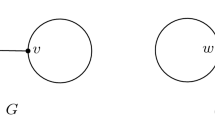Abstract
It is known that all minimum cuts in a networkN can be embedded in a cactus whose size is bounded by a linear function of the number of vertices inN, such that any minimum cut ofN can be easily obtained as a minimum cut of the cactus. However, such a representation for a given network is not unique. We introduce two canonical forms of cactus representation for the minimum cuts and show their uniqueness. These cacti contain at most twice as many vertices asN.
Similar content being viewed by others
References
M.O. Ball and J.S. Provan, Calculating bounds on reachability in computer networks, Networks,13 (1983), 253–278.
R.E. Bixby, The minimum number of edges and vertices in a graph with edge connectivityn andm n-bonds. Networks,5 (1975), 253–298.
E.A. Dinits, A.V. Karzanov and M.V. Lomonosov, On the structure of a family of minimal weighted cuts in a graph. Studies in Discrete Optimization (in Russian), (ed. A.A. Fridman), Nauka, Moscow, 1976, 290–306.
H.N. Gabow, Applications of a poset representation to edge connectivity and graph rigidity. Proc. 32nd IEEE Symp. Found. Comp. Sci., 1991, 812–821.
J. Hopcroft and R.E. Tarjan, AO(V 2) algorithm for determining isomorphism of planar graphs. Inform. Process. Lett.,1 (1971), 32–34.
A.V. Karzanov and E.A. Timofeev, Efficient algorithm for finding all minimal edge cuts of a nonoriented graph. Kibernetika,2 (1986), 8–12; translated in Cybernetics, (1986), 156–162.
H. Nagamochi, Z. Sun and T. Ibaraki, Counting the number of minimum cuts in undirected multigraphs. IEEE Trans. Reliability,40 (1991), 610–614.
H. Nagamochi and T. Ibaraki, A linear time algorithm for computing 3-edge-connected components of a multigraph. Japan J. Indust. Appl. Math.,9 (1992), 163–180.
H. Nagamochi and T. Kameda, An efficient construction of cactus representation for minimum cuts in undirected networks. Tech. Rep. CSS/LCCR TR92-04, School of Computing Science, Simon Fraser Univ., 1992.
D. Naor, D. Gusfield and C. Martel, A fast algorithm for optimally increasing the edge connectivity. Proc. 31st Annual IEEE Symp. Found. Comp. Sci., St. Louis, 1990, 698–707.
D. Naor and V.V. Vazirani, Representing and enumerating edge connectivity cuts inRNC. Proc. 2nd Workshop on Algorithms and Data Structures (eds. F. Dehne, J.-R. Sack and N. Santoro), Lecture Notes in Computer Science 519, Springer Verlag, Berlin-Heidelberg-New York, 1991, 273–285.
Author information
Authors and Affiliations
Corresponding author
Additional information
This work was supported in part by grants from the Natural Sciences and Engineering Research Council of Canada, the Advanced Systems Institute of British Columbia, and in part by Grant-in-Aid from the Ministry of Education, Science and Culture of Japan.
About this article
Cite this article
Nagamochi, H., Kameda, T. Canonical cactus representation for minimum cuts. Japan J. Indust. Appl. Math. 11, 343–361 (1994). https://doi.org/10.1007/BF03167227
Received:
Issue Date:
DOI: https://doi.org/10.1007/BF03167227




